#Gharial hunting
Explore tagged Tumblr posts
Text
youtube
Gharial: Nature's Fish-Eating Specialist
Discover the fascinating world of the Gharial, a unique crocodilian adapted for a life in water! Learn about its diet, behavior, and habitat.
Check out my other videos here: Animal Kingdom Animal Facts Animal Education
#Helpful Tips#Wild Wow Facts#Gharial#Crocodile species#Fish-eating crocodile#Endangered species#Indian wildlife#Wildlife conservation#River habitat#Ganges River#Reptile documentary#Nature documentary#Animal facts#Rare animals#Aquatic predators#Wildlife photography#Crocodile behavior#Gharial hunting#Gharial conservation#National parks India#Reptile species#Freshwater reptiles#Animal kingdom#Wildlife enthusiasts#Nature lovers#Indian rivers#Reptile protection#youtube#animal behavior#fun animal facts
1 note
·
View note
Text
can i be a dweeb for a second? one thing that kind of bugs me about jurassic world’s indominus rex is that the teeth and jaws are clearly inferior compared to the t. rex. maybe it was on purpose to show that science can’t hope to outdo millions of years of natural selection? but indominus’s teeth (center) look more suited for hunting fish like spinosaurus (right) rather than a terrestrial apex predator like t. rex (left)



even the bottom front teeth being angled outwards is a token sign of aquatic predation rather than terrestrial hunting, it looks like a damn gharial

i didn’t like the movie so i havent seen it since it was in theaters but iirc the whole point of the indominus was “it’s bigger and badder than the t. rex” and that was only proven false in the finale fight between it and a t. rex. but what annoys me is how it’s so obvious that this thing would get its fucking shit rocked in a second by a t. rex (the most badass thing that has ever lived on earth) and it’s clear just by looking at it
41 notes
·
View notes
Text

Day 5 of January extinct birds - the Auckland Island merganser (male depicted)
Don't have the energy for a full doodlestration so something a bit quicker today. This merganser is what started this project! Mergansers are epic - they're ducks with the bill of a gharial, complete with 'teeth' and a crest. 10/10 creature design. So when I discovered mainland NZ (where I live) used to have mergansers I was in shock and immediately went googling for other extinct birds that I didn't know about.
The population was wiped out by people and introduced animals just 60 years after their discovery! By the time Europeans got to NZ, the auckland island merganser was restricted to islands, but there is evidence of indigenous people hunting mergansers on the mainlaind hundreds of years ago. It's possible that the mainland species was the chatham island merganser though they seemed to have went extinct thousands of years ago. These are strange amongst mergansers since they appeared to be marine birds, but all other mergansers breed in freshwater environments. Also, NZ mergansers and the very very endangered Brazilian merganser are the only species to live in the southern hemisphere.
Have I mentioned how cool mergansers are.
#bird of the day#bird art#extinct animals#digital illustration#digital art#procreate#birds#bird#daily art#anseriformes#anatidae
162 notes
·
View notes
Text
Okay so I’m watching a Jim Henson production called “The Animal Show” AND WHEN I TELL YOU IT’S AMAZING IN EVERY WAY THO-
youtube
Not only is Sly the crocodile a freaking DELIGHT, they show baby crocodiles AND GIVE GHARIALS RECOGNITION!!!!!!!!!!
BC WE ALREADY KNOW ABOUT ALLIGATORS AND POSSIBLY CAIMANS BUT I NEVER SEE ANYBODY REALLY TALKING ABOUT GHARIALS SO THANK YOU SM
youtube
OK SO LAZLO THE HYENA IS A GREAT CHARACTER BUT YK WHAT I LOVE? THEY GET HYENAS. LAZLO ISN’T PORTRAYED AS A VILLAIN HE JUST ACKNOWLEDGES THE REPUTATION HYENAS GET AND JAKE (a polar bear) ARE LIKE “wow, I have a new respect for hyenas!”. He does something the Lion Guard doesn’t: he explains he’s not a scavenger. He says ofc they eat the dead but they mostly hunt for their food and I think that’s beautiful
OH AND HE SINGS A SONG ABOUT HYENAS.
WE GET A POSITIVE REPRESENTATION FOR A HYENA!!!!!!!!!
youtube
Again, no villainization in any way. Vic is a very tough nile monitor (like NY mobster tough), but in a respectable way. And he teaches everyone about monitor lizards!!!!
And another lovable crocodile character, Frankie is also a very accurate croc 🥰🥰🥰
(plus more bby crocs in this episode 🥺)
#Youtube#i love this show already#i’ll reblog when i watch more episodes :))))#vic and frankie having ny accents is fucking great#FRANKIE JUST TOLD JAKE AND STINKY HOW CROCS TAKE CARE OF THEMSELVES YOU TELL HIM#him telling stinky the skunk to chill out when the mama croc was carrying her babies was great#the animal show#jim henson
16 notes
·
View notes
Text
Okay but spinosaurus is literally the greatest creature to have ever roamed this planet. Spinosaurus wasn't created by God, but it wasn't put in this world by the devil to punish it. Spinosaurus came into this world against the combined forces of God, Satan, the Holy Spirit AND Lucifer, all together, and they were overpowered by spinosaurus, which spawned itself into the world with the purpose of bringing chaos and suffering to it. Spinosaurus is an unholy abomination, a 15 meters long mixture of a crocodile, a shoebill stork, a gharial, an alligator, a grizzly bear, a chub, and whatever other animal could be combined into the Cretaceous equivalent of a platypus, but evil.
And the thing is, spinosauridae isn't even consistent in that. most spinosaurids are a lot less crazy than the big man himself, Baryonyx, for example, is more just a big bipedal crocodile that hunts more like a grizzly bear. nothing crazy with that, right? but then in Egypt, Spinosaurus had to come along and specialise itself into fishing more than any spinosaurid ever dared to. and, it makes sense, because the area spinosaurus lived in had a carnivore occuppying just about every carnivore niche you could possibly think of, so what was left? obviously, stork with gigantism, what else could it be?
Spinosaurus was so evil, that once it was extinct, God went out of his way to stop any creature from ever remembering its existence, spinosaurus's original bones were FUCKING BOMBARDED in the museum they were kept in. Then, years later, before any new spino bones were found, they found Oxalaia's bones, which was probably very similar to spino- AND HISTORY REPEATS, Oxalaia's bones were burnt to ashes in the museum it was kept in.
But God failed, God made a mistake. even God wasn't able to stop spinosaurus from being remembered forever, and more spino bones were found and studied, and that led into us knowing about the existence, and having an idea of a lot of things about that unholy abomination that once tormented this planet. and we are doomed because of it. we don't have much longer, we disturbed the fish eating beast.
8 notes
·
View notes
Text
10 Lesser-Known Animals and Their Unique Eating Habits 🦜🌿
Aye-Aye (Daubentonia madagascariensis)
Habitat: Madagascar 🌴
Diet: Insects, particularly wood-boring grubs 🪲
Feeding Habits: The aye-aye uses its long, thin middle finger to tap on trees to locate hollow chambers where grubs reside. Once a grub is located, it gnaws a hole in the wood with its forward-slanting incisors and uses its elongated finger to extract the grub. 🦷👆

Blobfish (Psychrolutes marcidus)
Habitat: Deep sea, off the coasts of Australia and New Zealand 🌊
Diet: Crustaceans, sea urchins, and other deep-sea creatures 🦀
Feeding Habits: The blobfish lacks muscles, so it doesn't actively hunt. Instead, it floats along the sea floor, opening its mouth to suck in any edible matter that drifts by. 🍽️

Pangolin (Pholidota)
Habitat: Various habitats across Asia and Africa 🌍
Diet: Ants and termites 🐜
Feeding Habits: Pangolins have long, sticky tongues that they use to probe ant and termite nests. They have strong claws to break into the nests and a sticky tongue to lap up the insects. 👅

Gharial (Gavialis gangeticus)
Habitat: Rivers in the Indian subcontinent 🌊
Diet: Fish 🐟
Feeding Habits: The gharial has a long, narrow snout filled with sharp teeth, perfect for catching fish. It uses a swift side-to-side snapping motion to catch fish swimming by. 🐊

Star-Nosed Mole (Condylura cristata)
Habitat: Wet lowland areas in North America 🦔
Diet: Small invertebrates, aquatic insects, worms 🪱
Feeding Habits: This mole uses its star-shaped nose, covered in sensory receptors, to detect prey. It can identify and consume small prey in a fraction of a second. 🌟

Hoatzin (Opisthocomus hoazin)
Habitat: Swamps, river forests of the Amazon Basin 🌳
Diet: Leaves and vegetation 🍃
Feeding Habits: The hoatzin has a specialized digestive system that ferments vegetation similar to a cow’s stomach. It spends hours digesting leaves in its crop, a part of its digestive tract. 🐦

Numbat (Myrmecobius fasciatus)
Habitat: Eucalyptus forests in Australia 🌏
Diet: Termites 🐜
Feeding Habits: Numbats use their long, sticky tongues to probe into narrow crevices and galleries within termite mounds. They can eat up to 20,000 termites a day. 👅

Leafcutter Ant (Atta spp.)
Habitat: Tropical rainforests in Central and South America 🌲
Diet: Fungi that they cultivate 🧫
Feeding Habits: Leafcutter ants cut leaves and carry them back to their nests, where they use the leaves to grow a special fungus, which serves as their primary food source. 🍄

Purple Frog (Nasikabatrachus sahyadrensis)
Habitat: Western Ghats of India 🌄
Diet: Termites 🐜
Feeding Habits: Spending most of its life underground, the purple frog comes out only during the monsoon season to breed. It uses its specialized tongue to feed on termites in underground colonies. 🐸
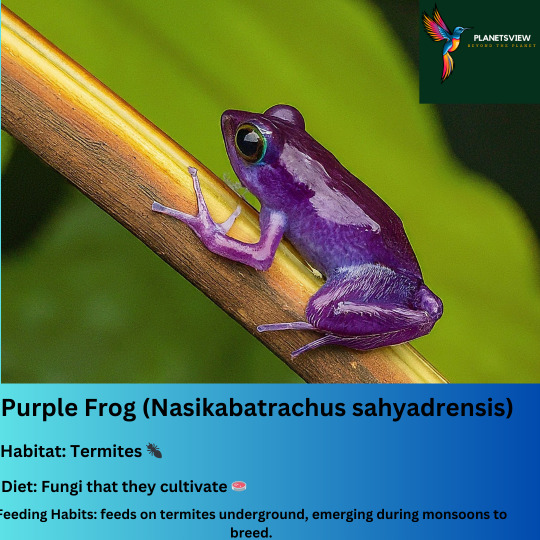
Vampire Finch (Geospiza difficilis septentrionalis)
Habitat: Galápagos Islands 🌴
Diet: Blood of other birds, insects 🌿
Feeding Habits: The vampire finch pecks at the skin of larger birds like boobies to drink their blood. This behavior likely evolved due to scarce food resources. 🦜

These lesser-known animals each have unique and fascinating feeding habits that highlight the incredible diversity of the natural world. 🌍✨
#animals#plants#forest#animal#wildlife#planet#nature#nature photography#naturelovers#natureconservation#animal protection#animal print#animal products
7 notes
·
View notes
Text
Happy Dracones Monday! Cliff Dragon

This is a rough dragon design that changes a lot every time I draw it. I want seagull dragons in Dracones Mundi - this is different from every other dragon species, which is based on pop culture or mythology, whereas these are just 'what if dragons were like seagulls?'
I want to combine long thin piscivorous jaws, like gharials, and tail flukes like metriorhynchoids, a four winged flying fish aesthetic, and just make a little dragon that clings to cliff faces and flies out to sea to hunt. I think the How to Train Your Dragon books inspired me a lot as a small child and I think cliffs should have dragons roosting on them. :)
For a dragon every monday follow @draconesmundi
71 notes
·
View notes
Text
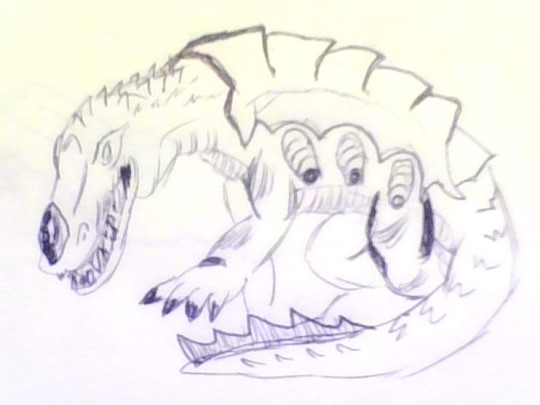
Another old sketch, one of the first MonHun muses I had; a fanged wyvern combining traits of gharials and gorgonopsids. - TORRENIAL Title - Gharial wyvern Monster class - Fanged wyvern Known locales - Coastal regions, marshlands and oases Element/ailment - Water Elemental weakness - Ice (3), Thunder (2), Dragon (1), Fire (0), Water (0) Ailment weakness - Poison (2), Stun (2), Blast (1), Paralysis (1), Sleep (1) Torrenial is a fanged wyvern predominantly native to coastal regions and marshlands, with some populations eking out a living by desert oases and rivers. Distinguished by its long snout and pale-brown colours, Torrenial is a formidable apex predator whose defensive integrity of its scutes complements its powerful jaws. Six flexible ports along its sides discharge water at high pressure from internal sacs, enabling both bursts of mobility and surprisingly effective projectile attacks. Torrenial is an ambush predator that specialises in lurking in shallow bodies of water, usually in the lagoons or rivers in coastal regions. It patiently waits for prey to come to the water's edge before lunging, combining its own sheer strength with bursts of speed to seize the victim and drag it underwater. It occasionally ventures into deeper water to catch fish if need be. Excelling in catching prey and rivals by surprise, Torrenial is liable to attack most anything that passes by the water, but it is comparatively passive if traversing on land. While humans are not usually worth the predator's interest, field workers are nevertheless advised to stay away from Torrenial and not to go near shallow bodies of water without first checking the fanged wyvern isn't present. Its ability to discharge water from its ports makes Torrenial formidable. It can change directions, reverse or strike from a distance with controlled bursts of water. Combined with its strength and jaws, this allows Torrenial to easily overpower most other monsters, especially if in its element. Torrenial exhibit sexual dimorphism; adult males have a large sturdy knob on their snout called a ghara. Males use the ghara to display to females and intimidate rival males, resonating sound through it to signal their vitality. Males are highly competitive, contending for territories that ideally overlap with three to four females; usually they use their ghara to settle disputes, but occasionally they will resort to wrestling; these brawls rarely result in injury. The females in a male's territory congregate to lay eggs at the centre of his turf, which the male diligently guards until the infants hatch and disperse to shadow their mothers. Their father will tolerate them but no longer makes an effort to protect them. The mother's care will only last for a year or so until the juveniles are old enough to find their own way in the world. As an apex predator comparable to monsters like Rathalos, Torrenial should only be challenged by experienced hunters (Low Rank - 5, High/Master Rank - 4). Hunters must be wary of facing the fanged wyvern in its natural environment; Torrenial may be lurking in any body of water, waiting to strike. Sonic bombs can surprise and expose it, and keeping the fight on land is crucial for forcing the fanged wyvern to empty its aqua sacs, reducing its effectiveness. Fully grown Torrenial knows few threats beyond elder dragons. Coastal individuals occasionally contend with competition from the likes of Plesioth or Lagiacrus, but hunting further inland alleviates this issue. Individuals in the desert can run afoul of the likes of Monoblos, but taking to the water allows them to avoid a needless fight. Juveniles, of course, can become prey for carnivores like Hyborlex, but a vigilant adult can see off most threats. - Thanks for reading and take care
9 notes
·
View notes
Note
can you tell me some really silly things about crocodiles and alligators??? man i wanna know what you know :3
Well, fun fact, there's only two alligator species in the world. There are 17 crocodiles, 2 gharials, and 6 caiman. But because there are so many American Alligators (about 5 million), they alone have a higher population than every other species combined. They're not endangered, however the US lists them as a protected species, because hunters can mistake them for American Crocodiles, which are critically endangered. So to prevent them from accidentally killing one, alligators are also pretty regulated in terms of hunting.
The other alligator species is the Chinese Alligator. There's only about 120 of them left in the wild, and they're pretty hard to find, because they bury underground.
Orinoco crocodiles are one of my faves because they just look like pancakes basically. I also like gharials because they look fucking ridiculous.
Also look up the noises baby crocodiles make. They sound like terrible sound effects from 1950s space movies.
5 notes
·
View notes
Text
You can also use these principles to determine the ecology of other fish species just by looking at them! Let's apply what we've learned to some more species:

Alligator Gar (Atractosteus spatula)
Notice that, once again, the tail is rounded and the dorsal and anal fins are placed posteriorly on the body. This is a heck of a lot like the arowana, and might indicate that the gar is also a slow-moving ambush predator - which it is! The reason the dorsal and anal fins are placed so far back on the body in ambush-hunting fish is because this placement allows them to work in tandem with the tail fin to provide a massive but short-lived burst of speed. When the dorsal and anal fins are positioned toward the middle of the body, the motion of the tail does not affect them as much and so they tend to act more as stabilizers and do not contribute to propulsion (though see the Tetraodontiformes for a very weird and cool exception).
Notice that, while the head is again long and flat, the mouth is not nearly so upturned as in the arowana but instead is positioned to face forward. This suggests that, while the gar can hunt at the surface, it's more at home looking for prey in the midwater. In Ichthyology, this kind of mouth is called a terminal mouth (as opposed to the arowana, which has a superior mouth. To complete the trifecta, many bottom-dwelling fish like catfish have inferior mouths that point downward.) Alligator gar do use suction feeding, but they also rely on lateral snapping to capture prey. In this feeding style, the fish explosively swipes its flat, thin, toothy mouth to the side and ensnares the target in its teeth. Lateral snappers tend to be slow-moving predators of much smaller, faster, schooling fish. This feeding style is also used by needlefish, which have a similar jaw structure to gars, and even the Gharial!
Also notice that the gar and the arowana both have long, smooth, roughly cylindrical bodies with a pointed head (though it's less pronounced in the arowana, which has a more flattened body). In Ichthyology, this body type is called sagittiform and is - quelle surprise! - also associated with sit-and-wait ambush predators that rely on quick bursts of speed! Other fish which display this body type include pikes and barracuda, both of which are (wait for it) ambush predators.
Let's look at a different kind of fish now:

Foureye Butterflyfish (Chaetodon capistratus)
Again, let's look at the shape of the fins and body and size and position of the mouth to figure out how this fish does its thing.
The tail fin is, again, rounded. This is not a fish that habitually swims at high speeds. Fish that regularly swim fast usually have emarginate, forked, or lunate tails.
The body is very flat side-to-side, giving this fish a compressiform body shape. This shape is excellent for fish which need to be agile, since it allows them to make very tight turns in a very narrow space, and is often seen in fish which inhabit very complex environments, like coral reefs or beds of aquatic vegetation. Compressiform fish tend to be prone to tipping over while swimming; to combat this, many such fish have long and large dorsal and anal fins that act as both stabilizers and rudders. Other fish with a compressiform body plan include angelfish, surgeonfish, and freshwater sunfish. This particular species lives in the nooks and crannies of Caribbean coral reefs.
The mouth is small, and terminally positioned. This fish is not likely to be eating other fish or other large organisms - they just wouldn't fit. Instead, it's likely to eat small prey, like plankton, algae, or small crustaceans, which it collects from directly in front of it rather than above or below. You can't tell by looking at them, but most butterflyfish are actually specialist predators of coral polyps - they have comb-like teeth which they use to scrape away the soft, gelatinous flesh away from the underlying stone!
Lastly, I know it's not technically part of the "body shape" but I want to talk briefly about colouration. The first thing we notice is the bold black spot at the base of the caudal fin. This is an eyespot, and is often seen in fish which are vulnerable to predation (as well as many other animals). It's intended to distract the predator into attacking the relatively unimportant tail and leaving the head and vital organs alone. Notice also that the stripe across the face continues onto the eyeball and obscures the pupil - this serves the same purpose, obscuring the eye and deflecting attention away from the head!
So, to summarize, the alligator gar, like the Asian arowana, is a slow-moving ambush predator which relies on bursts of speed to capture fast prey; it tends to feed on prey items directly in front of it, which it catches with quick lateral snapping of the jaws. The foureye butterflyfish, by contrast, is a slow but very agile fish which lives in a very complex underwater habitat; it eats small, inoffensive food items and has to deal with the threat of larger predators, which it uses its artificial eyespot to confuse and escape from. We can determine all of this just by looking at them. This kind of deduction is instrumental in predicting the lifestyles of fish which we can't observe in their natural habitat. Using these techniques we can figure out the ecology of deep-sea fish that have only ever been documented as mangled specimens caught in trawling nets, rare or secretive species that have never been seen by divers, or of fossil fish whose lives and livelihoods are lost to time. It's incredible that we can learn so much about a fish just from what it looks like.
The body shape of a fish can tell you a lot about it! It can tell you where they like to hang out, how they hunt, what they eat, and more!
Let's use the Asian Arowana (Scleropages formosus) as an example!

Based off the rounded caudal fin (the "tail"), this fish is not a very fast swimmer
Having the dorsal fin and anal fin right near the end of the fish's body suggests it is an ambush predator
The flat head suggests it hunts at the surface
The upturned, large mouth suggests it catches its prey from below
Arowana are ambush predators that hunt at the surface!
They don't need to go very far very fast, hence the rounded caudal fin (which is the slowest moving fin)
Having posterior dorsal and anal fins are a common trait amongst ambush predator
They primarily hunt at the surface! They will sit near the surface and grab small fish, bugs, crustaceans, and even occasionally a bird!
4. Fish that catch their prey from below sometimes do it via suction. They'll open their large mouth, and as the water gets sucked in, so does anything in the water. And the larger the mouth, more water will more quickly fill into the mouth, catching larger and faster prey
5K notes
·
View notes
Text
Tiger Tales: Tracking the Wild in Ranthambore and Dudhwa
Tiger Tales: Tracking the Wild in Ranthambore and Dudhwa
India is renowned for its majestic tigers and the protected sanctuaries where they thrive. Among these, Ranthambore National Park and Dudhwa National Park stand out as prime destinations for tiger tracking and wildlife exploration. Both parks offer unique experiences, from Ranthambore’s rugged terrain to Dudhwa’s dense grasslands, making them irresistible for wildlife enthusiasts and photographers alike.
This guide dives deep into the offerings of these two iconic parks, helping you plan an unforgettable tiger safari.
Ranthambore National Park: Where History Meets Wilderness
Overview
Located in Rajasthan, Ranthambore National Park is a perfect blend of wildlife and heritage. Once the hunting grounds of the Maharajas of Jaipur, this park is now a haven for tigers and other wildlife.
Highlights of Ranthambore:
Majestic tigers often seen lounging or hunting in open spaces.
The iconic Ranthambore Fort, a UNESCO World Heritage Site.
A rich diversity of flora and fauna, including leopards, sloth bears, and numerous bird species.
Best Zones for Tiger Tracking
Ranthambore is divided into 10 safari zones, each offering unique wildlife experiences:
Zone 3: Known for frequent tiger sightings and picturesque lakes.
Zone 4: A mix of dense forests and open spaces, offering excellent chances of spotting tigers.
Zone 2: Popular for its rich biodiversity and proximity to Ranthambore Fort.
Dudhwa National Park: The Terai’s Hidden Gem
Overview
Nestled in Uttar Pradesh’s Terai region, Dudhwa National Park is an untouched paradise known for its dense forests, grasslands, and wetlands. This park offers a tranquil escape and is home to the elusive swamp tiger.
Highlights of Dudhwa:
Vast grasslands perfect for spotting tigers, elephants, and barasingha.
The unique Terai ecosystem, home to over 400 bird species.
Opportunities to explore the nearby Kishanpur and Katarniaghat Wildlife Sanctuaries.
Best Zones for Tiger Tracking
Salukapur Range: Known for its tiger sightings amidst thick sal forests.
Bankati Range: Offers a mix of grasslands and water bodies, ideal for photographing wildlife.
Kishanpur Wildlife Sanctuary: Known for its swamp deer population and occasional tiger sightings.
Safari Experiences in Ranthambore and Dudhwa
Ranthambore Safari Experience
A typical Ranthambore safari begins early in the morning or late in the afternoon. Visitors can choose between jeep safaris or canter safaris to explore the park. The rugged terrain, interspersed with lakes and ruins, provides a dramatic backdrop for wildlife encounters.
Dudhwa Safari Experience
Dudhwa offers a more rustic and immersive safari experience. In addition to jeep safaris, elephant-back safaris allow visitors to traverse areas inaccessible by vehicles, offering a unique perspective of the park's dense forests and grasslands.
Wildlife Beyond Tigers
In Ranthambore
Leopards: Often spotted in rocky outcrops and cliffs.
Marsh Crocodiles: Found basking along the banks of the park’s lakes.
Avian Wonders: Peacocks, eagles, and kingfishers dominate the skies.
In Dudhwa
Swamp Deer (Barasingha): The park’s most iconic herbivore.
Gharials: These endangered crocodilians inhabit the rivers of Dudhwa.
Rare Birds: Look out for Bengal floricans, great hornbills, and painted storks.
Best Time to Visit
Ranthambore
October to June: Tigers are more active during this period, with peak sightings in summer.
Dudhwa
November to March: The cooler months offer pleasant weather and optimal conditions for wildlife viewing.
Tips for a Successful Safari
Prepare in Advance
Book Early: Both Ranthambore and Dudhwa are popular destinations, so secure your safari slots well in advance.
Carry Essentials
Binoculars, cameras, and extra batteries.
Comfortable clothing in neutral tones to blend with the environment.
Respect the Wildlife
Avoid loud noises or sudden movements.
Follow your guide’s instructions for a safe and enjoyable experience.
Comparing Ranthambore and Dudhwa
FeatureRanthamboreDudhwaTerrainDry, rugged terrain with lakesDense grasslands and wetlandsWildlife DiversityTigers, leopards, sloth bearsTigers, swamp deer, elephantsAccessibilityWell-connected by road and railRelatively remote and less crowdedUnique FactorHistorical ruins and fortUnspoiled wilderness
Why Choose Both?
While Ranthambore offers a more dramatic and royal safari experience, Dudhwa provides a serene and untouched atmosphere, perfect for those seeking solitude amidst nature. Together, they showcase the incredible diversity of India’s tiger reserves.
For seamless planning, ensure your safari bookings are arranged in advance. Learn more about Ranthambore safari booking and Dudhwa safari booking through reliable platforms like Banzaara Travels, ensuring an unforgettable wildlife adventure.
Embark on your tiger tale journey today and witness the wonders of India’s incredible wildlife sanctuaries!
0 notes
Text
Name: Mr. Ryan Beckett Color: Hunter Green #3f704d Symbol: skull Strife Specibus: chainsawkind Handle: grimAnachronism Animal: giraffe Pronouns: zhi/zhir/zhirs/zhirself Age: 18 Birthday: 360th day of the year Sexuality: nb4nb Interests: mushroom hunting and zoo visiting Dream Moon: derse Classpect: Prince of Blood Land: Land of Fire and Ghosts, a cheerful place, with magnificent Malayan Gharial consorts. It is a place full of a black desert and spider shaped ponds. Hyperion loves this land like their own spawn.. Instrument: kakaki
0 notes
Text
Allosaurus is honestly kind of an asshole, like, shit just pops in the jurassic, quickly becomes the most widespread and probably the most successful predator in the entirety of the Morrison formation, gives origin to Carchadontosaurids, AKA the only group of theropods to rival Tyrannosaurus the big man himself in terms of weight, and then just FUCKING DISAPPEARS? and the thing is, Allosaurus is known as the "Lion of the Jurassic", and there's a very accurate comparison there; we've never met Allosaurus, and because of that, an 8 meters long theropod that could outrun you and probably hunt even baby sauropods? ABSURDLY cool, almost mysthical even, but if we were to coexist with it? it'd become just about the most normal animal ever. just like lions, Lions are like, extremely special animals, but since they're the poster kid for the animal kingdom, we don't see them as weird. As more examples:
If you knew about a Prehistoric Mammal that was the tallest animal of it's time, had a neck so long it's head was basically untouchable, had to SPREAD ITS LEGS to drink water, its childs were fucking DEPOSITED into the world with a large fall the second they were born, AND with the majority of its population being gay, you'd find that to be an EXTREMELY cool animal, but since you already know a lot about Giraffes, they don't seem that special anymore.
Imagine knowing about a prehistoric lizard that could track down it's prey throughout the ENTIRETY OF THE CONTINENT it lived on, had a toxic bite that took us a WHILE to understand how it actually works, reproduced asexually, you'd find that to be an extremely cool animal! but you already know about Komodo Dragons, so they seem relatively normal.
Basically, it doesn't matter how cool an animal is, if it's a 15 meter long gharial stork chub grizzly bear, if it's a bird that weighs two hundred kilos and kills sabertooth cats, if it's the biggest animal to ever fly, if it's an 8 meter fast running baby sauropod hunter, if you're exposed enough to that animal, it's gonna seem normal, and the most famous animals just happen to be the most "special" ones, making them seem way less special and weird than they actually are.
2 notes
·
View notes
Text
So a creche in ecology is a group of animals that take care of their offspring as a group. Grouping together like this can help with protection against predators, finding food, enduring the weather, and gives the parents time to "rest", as sometimes the parents will alternate who's being the primary watchers while others get to hunt by themselves for a bit, like a baby animal daycare.
But ye lions do this once cubs each a certain age. A decent amount of birds do it (for example: flamingos and a lot of penguin, duck, and goose species). Gharials (a type of South Asian crocodilian) form creches with hundreds of babies from multiple nests (they lay under 100 eggs each and sometimes as few as 20). Feral hogs tend to form groups of mothers and young like this, and I saw 3 sows and like 15+ tiny babies the other day and they were so cute
But ye that's how you get pictures like these





big fan of when animals creche. Love to see so many fucking babies in one place
27K notes
·
View notes
Text
Also did you guys know that river monsters (where biologist jeremy wade catches and releases obscure species of “monster” fish) only ended bc he caught all of them. There were literally no more monster fish left.
#said it once and ill say it again: river monsters is the best bc it’s the only monster hunting show where they actually catch the monster#(AND RELEASE)#also he saw a gharial one time unexpectedly which like hands down coolest moment on the show#susan watches too much reality tv
5 notes
·
View notes
Text
Mid-2022 gharial news round-up.
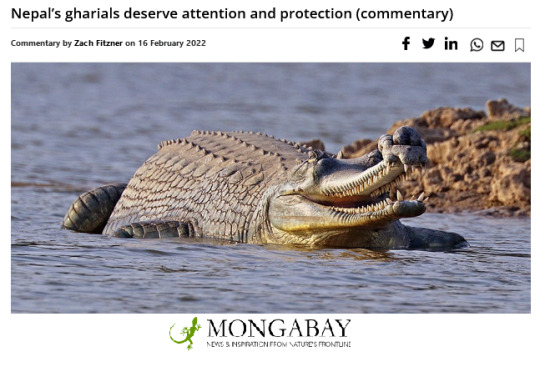
The gharial (Gavialis gangeticus, the large, conspicuous, and extremely unique fish-hunting crocodilian of the Indus, Ganges, and Brahmaputra river systems) is extinct in Bhutan, Myanmar, Bangladesh, and Pakistan. The crocodilian now only survives in small populations in India and Nepal, with perhaps only 200 breeding-capable wild adults surviving.
But now Pakistani land managers are formally requesting that Nepal provide gharials for reintroduction in the Indus river system in Pakistan, where they’ve been extinct for nearly 40 years. [Source: Abhaya Raj Joshi. “Return of the king? Pakistan moves to bring gharials from Nepal to its rivers.” Mongabay. 2 July 2022.]


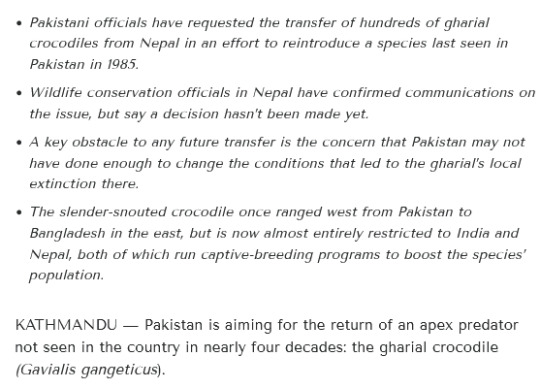
---
For the first time in nearly 20 years, new wild-born gharial hatchlings have been spotted in critical gharial habitat in Nepal’s Karnali River. [Source: Abhaya Raj Joshi. “First gharial hatchlings spotted in nearly two decades in Nepal’s Karnali River.” Mongabay. 20 June 2022.]

---
In 2016, it was discovered for the first time that gharials had been successfully nesting in the Gandak river system. After the release of another 148 gharials, as of 2022, it has been determined that the Gandak river is now home to the second-largest population of gharials in India. [Source: Patna News. “‘Gandak now second largest gharial population in country.’“ As published at The Hindustan Times. 3 July 2022.]

---
More discussion of wild gharial hatchlings in Nepal. [Source: Abhaya Raj Joshi. “New gharial hatchlings in Nepal a hopeful sign for the critically endangered reptile.” Mongabay India. 28 June 2022.]

---
Reintroduced gharials are expected to begin successfully breeding in the wild in the Punjab. [Source: Vikas Vasudeva. “Reintroduced gharials thriving in Beas reserve: experts.” The Hindu. 18 December 2021.]

---
For context.
Historical distribution range of the gharial:
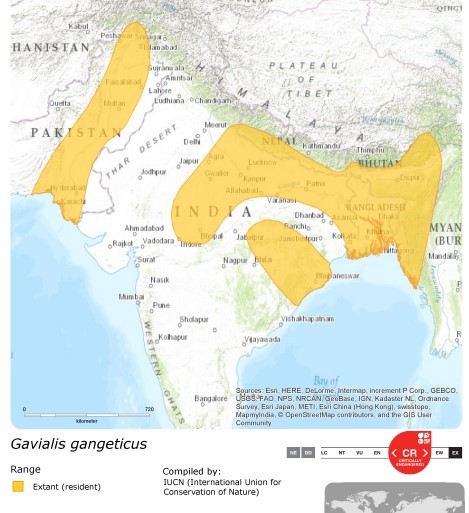
And current distribution range.
Gharials are now extinct in Pakistan, Bhutan, Myanmar, and Bangladesh:

172 notes
·
View notes